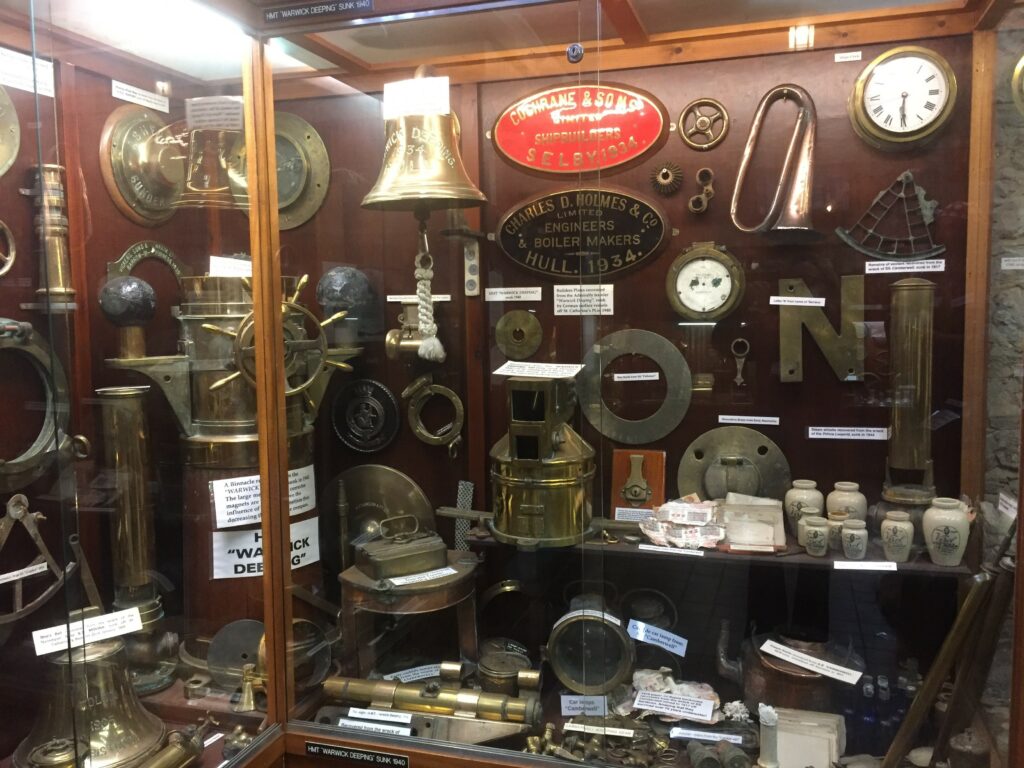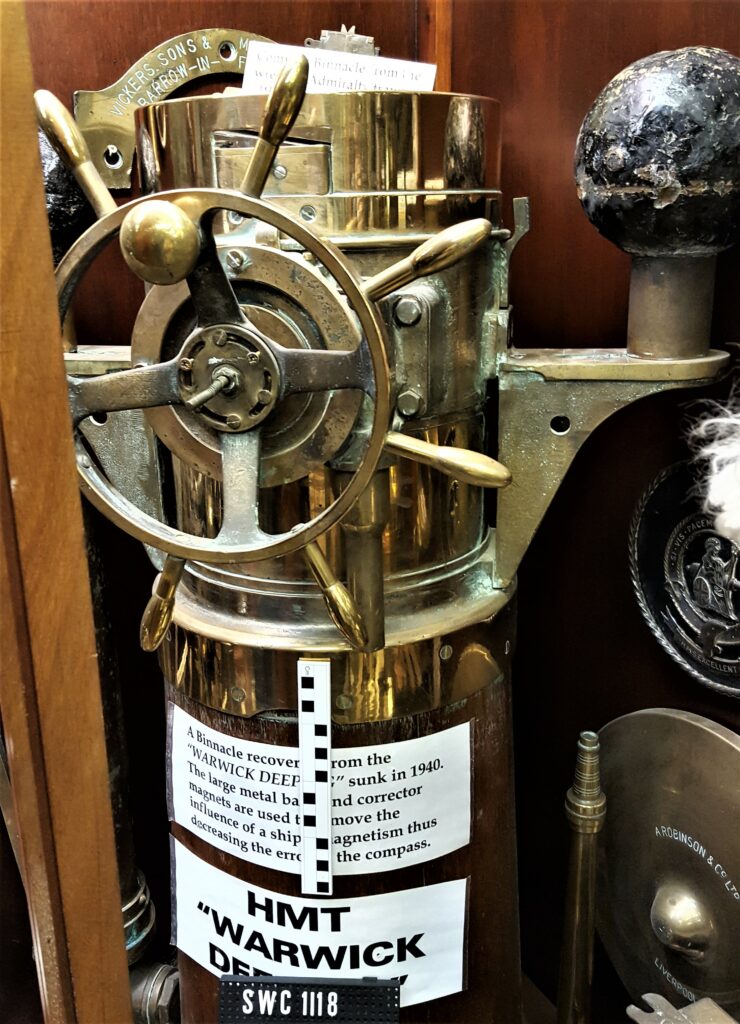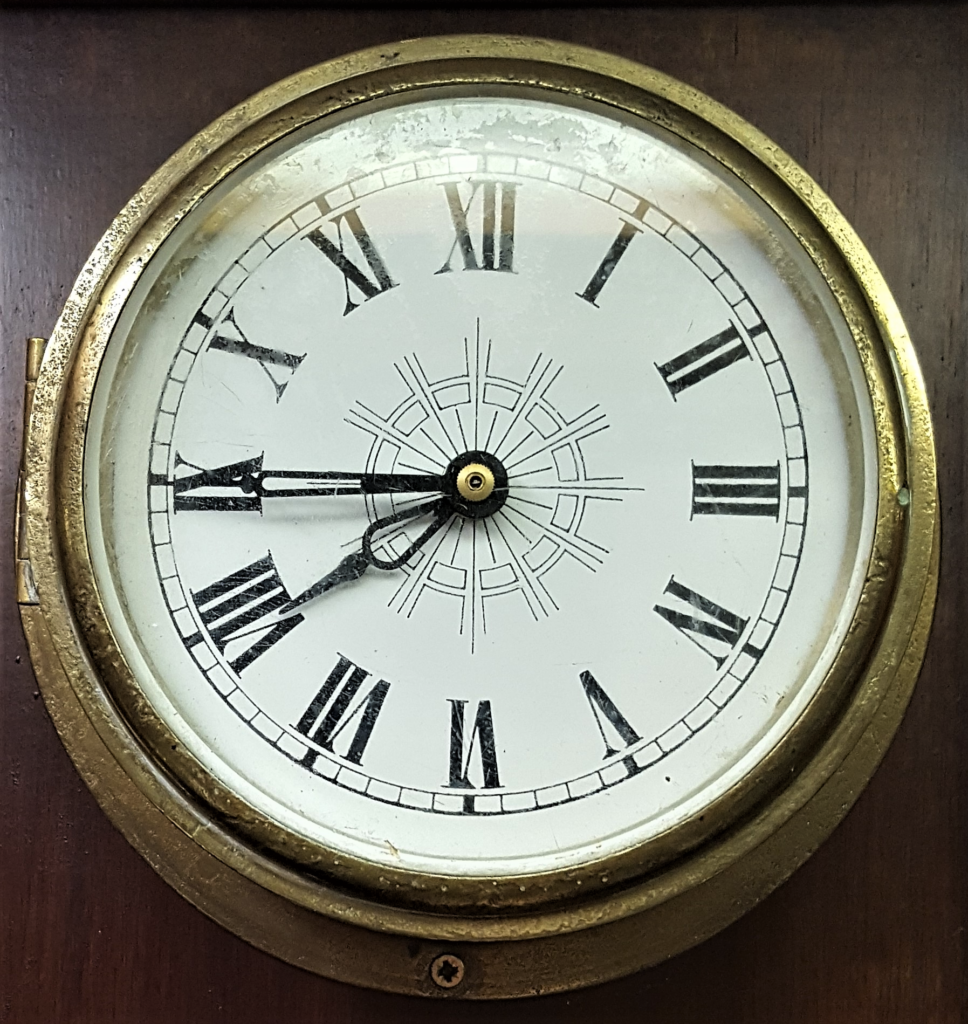Volunteer Roger Burns describes the 1940 loss of the steam trawler Warwick Deeping, bought by the Admiralty at the outbreak of the Second World War and converted into an Anti-Submarine Patrol vessel, and outlines recovered artefacts at the Shipwreck Centre and Maritime Museum and the seabed wreckage off the Isle of Wight.
When the Second World War started, the Admiralty was in need of additional mine sweepers and anti-submarine vessels, so, recognising the sturdiness of fishing vessels, purchased or requisitioned many such privately owned vessels with crews experienced in all-weather situations. Not only were these vessels sturdy, they were already fitted with winches suitable for sweep wires and their open deck layouts made them very suitable for conversion.
The ship
ST Warwick Deeping was purchased by the Admiralty in early August 1939 from the Newington Steam Trawling Company Ltd, St. Andrew’s Dock, Hull for whom it was built by Cochrane & Sons Shipbuilders Ltd., of Selby, launched on 11 October 1934, and completed two months later. It was a steel-hulled vessel, 47.49m long, with 7.96m beam and a depth of 4.3m, and powered by a triple-cylinder steam engine by Charles D. Holmes & Co. Ltd., Hull, designed for low coal consumption at speed. Developing 111nhp (83kW), the vessel was capable of 11.7knots driven by its single 4-bladed propeller. It was registered at Hull on 7 December 1934 with ON163958, 445grt, and assigned fishing registration H136. Designed for fishing in the northern waters of Iceland, Bear Island, and the White Sea, it was also fitted with steam winches, electric depth recording apparatus and wireless.
Included in a batch of 40 similar vessels for conversion on Wearside, the Warwick Deeping arrived there on 14 August 1939 and was repurposed as an anti-submarine patrol vessel, pennant FY182, armed with 1×4-inch forecastle gun, a twin barrelled 0.5-inch machine gun and depth charges, fitted with ASDIC (an early type of sonar). Commissioned on 22 September 1940 and assigned to Western Approaches Command, based at Swansea, the Warwick Deeping was commanded by Lt. Commander Kenneth McMillan Drake, RD, RNR until May 1940. The ship was then assigned to the 17th Anti-Submarine Group at Portsmouth, commanded by John Robert Bruce, RNR until lost.
The Loss
On Friday 11 October, 1940, the Warwick Deeping, crewed by 25 and commanded by Bruce left Portsmouth to patrol around the Isle of Wight, in company with the Listrac. The Listrac was also part of the 17th Anti-Submarine Group, and an armed anti-submarine Admiralty owned vessel, converted from a larger 1907 built French coastal cargo trading steamer which had been under German control between 1916 and 1919 until returned to the French owner. By 10pm, the two boats were approximately ten miles south of St Catherine’s Point in calm weather, with bright moonlight giving good visibility of two to three miles.
Meanwhile, the German Torpedo Boats (more akin in size to Royal Navy destroyers than Motor Torpedo Boats) Falke, Grief, Kondor, Seeadler and Wolf of the German 5th Torpedo Boat Flotilla departed from Cherbourg to conduct an aggressive patrol of the Channel, in the wake of a bombardment of their port the previous night by HMS Revenge. At 10.35pm a lookout on the Warwick Deeping spotted ships on the port quarter. Within seconds the two ships found themselves under fire and splashes appeared around the ships. Listrac, wrongly believing they were friendly vessels, lit its recognition lights; shortly after, it was struck by shells and such severe damage was done that it began to sink, the attacking German ships continuing to fire at it, including being torpedoed by Grief sinking it. Eleven men died, five during the action and six more from their wounds.
About two to three minutes after the first shots were fired, the Warwick Deeping was hit by Kondor and Falke. One shell wrecked the forecastle gun and another hit below the water line on the port side. Also torpedoed, one missed and one failed to explode on contact. An emergency radio broadcast was made and the ship began zig-zagging in a belated attempt to escape north. The German ships steered away, but went on to sink two French vessels later that night.
Warwick Deeping continued north. Bruce hoped he might be able to beach the ship on the Isle of Wight coast, but the bow was down and the ship was labouring. Twenty minutes later with rising water in the engine room, it was evident that this was a forlorn hope and the crew abandoned ship. The Warwick Deeping sank unseen, presumably in the early hours of the 12 October. Rescued by two men in a motor boat from Ventnor, the crew’s rafts were towed to the shore without any casualties. The Bembridge lifeboat had been called out but was recalled with the successful rescue by the motor boat which belonged to Fred Gould, an on-duty ARP warden; he was assisted by his nephew Bert Chambers and the survivors were landed at 3am, receiving hospitality at an inn from Mr. and Mrs. W. Chandler.
The Wreck Discovery
Discovered during a magnetometer survey in 1982 by Martin Woodward, the previously unchartered wreck of the Warwick Deeping was untouched and one of the most intact wrecks in the area. The wreck lies facing east on shingle in about 37m of water off the south west coast of the Isle of Wight, some seven miles west of St. Catherine’s Point. The builder’s and machinery plates were on the front of the upper wheelhouse and were recovered, together with its Bell, binnacles and gunsight, all of which are on display in the Shipwreck Centre and Museum, Figure 1. The wreck is a popular dive site and has been subject to further recoveries including a brass window, 6×0.5-inch shell cases, a porcelain bayonet fuse, a towel rail, a deadlight porthole and an ink well (all held by sport divers).

Figure 1: Warwick Deeping’s & other wrecks’ artefacts


Figure 2: Warwick Deeping‘s Compass Binnacle & Clock. Images by MAT.
In 2010, the site was surveyed in visibility of about 6m. The wreck stands 6m above a flat seabed and was largely intact although the wheel house had collapsed, and there was a large hole port side amidships. Several areas of the deck timbers had survived, but hatches were open or rotted, with sand having migrated into the hold. The deck gun lay on its side to port towards the bow, and the funnel was on the seabed alongside but separate from the wreck. A 2011 YouTube video shows the wreck condition.
A further dive was carried out in November 2014, with images in Figure 3, courtesy of Trevor Jenkins.

